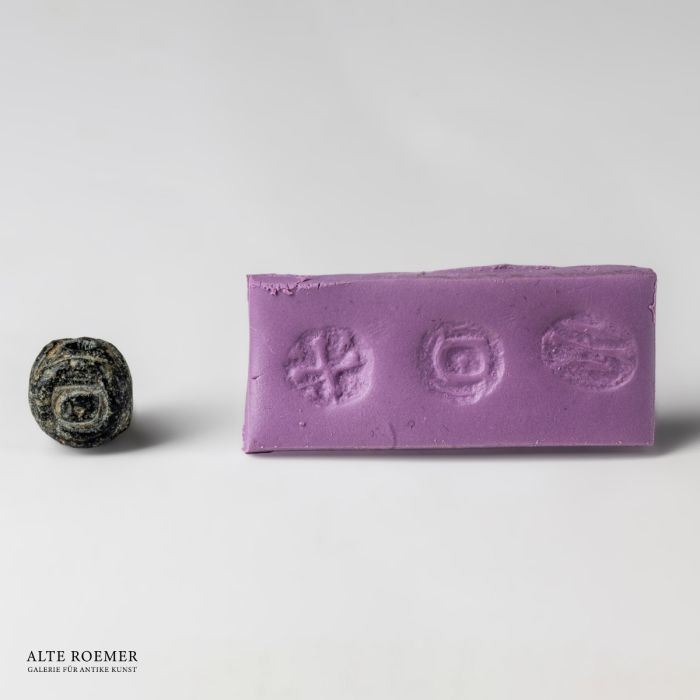Minoan seal from the Palace Period
€1,200
available
Object number
AR3520C
| Object: |
Minoan bead-shaped seal
|
| Material: |
Gray-green serpentine. A popular material for Minoan seals.
|
| Period: |
Middle Minoan IB to Middle Minoan II, Circa 1900 BC to 1800 BC, Aegaen Bronze Age. |
| Description: |
Minoan seal in the shape of a three-sided prism with rounded edges. It thus resembles a bead. The three sides form flat stamp surfaces with rounded corners, each surface separated by a surrounding groove. A hole made it possible to thread the seal like a bead. The three stamp surfaces show: a) a central cross with thickened ends and a triangular structure in each of the four fields. b) a central circle and, surrounding it, a rounded square with an irregular outer line, plus two stripes along the outer edge. c) three parallel lines, one with thick ends, one with thin ends, and one with a tripartite end. |
| Background: |
The Minoan seals of Crete offer a key to the Bronze Age world of the Minoans, whose culture flourished in the 3rd and 2nd millennia BC. These small, artfully engraved objects not only served as practical markings for goods and possessions, but also reflected religious ideas, social structures, and aesthetic principles. Glyptics developed into an independent art form on Crete. Animal depictions, cult scenes, and abstract symbols were carved into materials such as steatite, jasper, or agate. Compared to seals from Egypt or Mesopotamia, the Minoan pieces demonstrate remarkable originality, despite the close Mediterranean trade relations. For collectors and researchers, these seals are far more than artifacts. They are windows into a lost world whose secrets have aroused curiosity and the spirit of discovery since the time of Sir Arthur Evans. |
| Dimensions: |
Length 11.5mm. Diameter of surface a: 10.4mm - 10.7mm, surface b: 10.3mm, surface c: 10.3mm - 11.7mm. Hole diameter 2.6mm.
|
| Condition: |
Surface slightly bumped, otherwise perfectly preserved.
|
| Provenance: |
Acquired by us in 2023 on the German art market. Previously in the Grumach family collection. The founder Dr. Ernst Grumach acquired the seal before 1968. Dr. Ernst Grumach (1902–1967) was a broadly positioned scholar specializing in classical philology, Egyptology, and linguistics. He placed an emphasis on the proto-writings of the Bronze Age Aegean. His collection of Cretan seals was created with a keen eye for significant pieces. It was studied by Ingo Pini, presumably in the 1960s during Dr. Grumach's lifetime, and later published with funding from the German Ministry of Education and Research. |
| Publications: |
Described in detail and illustrated in Ingo Pini, Corpus der minoischen und mykenischen Siegel (CMS), Band XI Kleinere europäische Sammlungen, p. 83, no. 74 (Akademie der Wissenschaften und der Literatur Mainz, 1988). Digitized in Arachne, the central object database of the German Archaeological Institute, Arachne-ID 1160103. |
| Literature: |
Relevant publications by or about Dr. Ernst Grumach, E. Grumach, Bibliographie der kretisch-mykenischen Epigraphik (Berlin and Munich, 1961). Festschrift for the 65. birthday of Ernst Grumach (posthum), W. C. Brice, Studien zur Geschichte und Epigraphik der frühen Aegaeis (Berlin, 1967). |
| Authenticity: |
We unconditionally guarantee the authenticity of every artefact, all items are subject to our lifetime return policy on authenticity.
|


